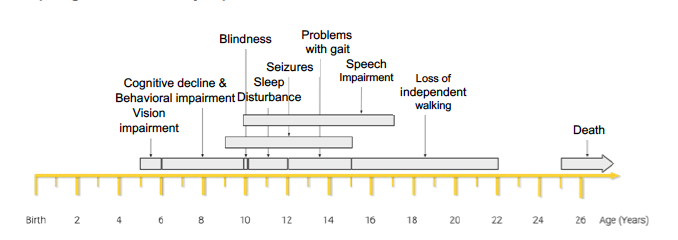Cardiology 2
Session: Cardiology 2
147 - Cardiac Findings in Individuals with CLN3 Disease (Batten Disease)
Friday, April 25, 2025
5:30pm - 7:45pm HST
Publication Number: 147.4075
Christina M. Harris, Howard University College of Medicine, Hyattsville, MD, United States; An Dang Do, National Institutes of Health, Bethesda, MD, United States; Banis Githinji, NIH, Lanham, MD, United States

Christina M. Harris, M.S. (she/her/hers)
Student
Howard University College of Medicine
Hyattsville, Maryland, United States
Presenting Author(s)
Background: Juvenile Neuronal Ceroid Lipofuscinosis (JNCL), or Batten disease, is an autosomal recessive disease caused by a mutation in the CLN3 gene. Batten Disease is a currently incurable lysosomal disease characterized by childhood-onset neurodegeneration and intracellular accumulation of ceroid lipofuscin, or auto fluorescent storage material in the lysosome. Previous studies have found the presence of cardiac abnormalities in individuals with Batten Disease suggested to be due to myocardial storage of ceroid lipofuscin. Cardiac abnormalities previously identified include repolarization disturbances, ventricular hypertrophy, sinus node dysfunction, bradycardia, atrial flutter, sinus arrest, and inverted T waves.
Objective: The goal of this project is to study cardiac findings in the NIH CLN3 (Batten) Disease Natural History protocol cohort.
Design/Methods: Participants in an NIH IRB-approved study protocol and their families visit the NIH annually and have procedures and extensive clinical evaluations performed by various specialists over the course of the week including the following cardiac evaluations: BNP lab, troponin lab, 24-hour Holter monitor, standard 12-lead EKG, and a transthoracic echocardiogram. Extracted data collected from EKG recordings of study participants from each annual visit was analyzed and studied, focusing on the heart rate, P-R interval, presence of T wave abnormalities, bradycardia, and left ventricular hypertrophy.
Results: The study consists of thirty-eight participants: nineteen male, nineteen female. Thirty-one participants (81.3%) showed sign of cardiac involvement. Twelve participants (39.5%) displayed bradycardia( < 60/beats/min.). Three participants (7.9%) displayed prolonged P-R interval (PR>200). Five participants (13.1%) displayed T-wave abnormality. Two participants (5.3) participants displayed left ventricular hypertrophy.
Conclusion(s): Individuals enrolled in the CLN3 disease (Batten Disease) Natural History study display signs of cardiac involvement including bradycardia, prolonged P-R interval, T wave abnormalities, and LVH. A bi-directional trend in heart rate and age is observed in both male and female participants, in which heart rate decreases with increasing age. Overall, a higher proportion of males displayed cardiac findings based on EKG data. Further analysis of the data is needed to address the following hypotheses: Cardiac involvement onset and progression differs between male and female participants, and onset of cardiac involvement differs for those who are homozygous for the deletion mutation vs. those who are compound heterozygous or have no deletion.
Figure 1. Onset of symptoms seen in individuals with Batten Disease.
 Each gray bar represents average age range of onset. [T.-R. (n.d.). Learn about batten disease & support from BDSRA Australia. BDSRA Australia.]
Each gray bar represents average age range of onset. [T.-R. (n.d.). Learn about batten disease & support from BDSRA Australia. BDSRA Australia.]Male participants heart rate at the age of first examination.
.png) Gray shaded areas depict the normal range of heart rates for the age intervals 0-1, 1-5, 5-10, 10-15, and > 15 years
Gray shaded areas depict the normal range of heart rates for the age intervals 0-1, 1-5, 5-10, 10-15, and > 15 yearsFemale participants heart rate at the age of first examination.
.png) Data point for the 80-year-old study participant was excluded for visualization purpose. The outlier increased the slope of the trendline. Gray shaded areas depict the normal range of heart rates for the age intervals 0-1, 1-5, 5-10, 10-15, and > 15 years
Data point for the 80-year-old study participant was excluded for visualization purpose. The outlier increased the slope of the trendline. Gray shaded areas depict the normal range of heart rates for the age intervals 0-1, 1-5, 5-10, 10-15, and > 15 yearsFigure 1. Onset of symptoms seen in individuals with Batten Disease.
 Each gray bar represents average age range of onset. [T.-R. (n.d.). Learn about batten disease & support from BDSRA Australia. BDSRA Australia.]
Each gray bar represents average age range of onset. [T.-R. (n.d.). Learn about batten disease & support from BDSRA Australia. BDSRA Australia.]Male participants heart rate at the age of first examination.
.png) Gray shaded areas depict the normal range of heart rates for the age intervals 0-1, 1-5, 5-10, 10-15, and > 15 years
Gray shaded areas depict the normal range of heart rates for the age intervals 0-1, 1-5, 5-10, 10-15, and > 15 yearsFemale participants heart rate at the age of first examination.
.png) Data point for the 80-year-old study participant was excluded for visualization purpose. The outlier increased the slope of the trendline. Gray shaded areas depict the normal range of heart rates for the age intervals 0-1, 1-5, 5-10, 10-15, and > 15 years
Data point for the 80-year-old study participant was excluded for visualization purpose. The outlier increased the slope of the trendline. Gray shaded areas depict the normal range of heart rates for the age intervals 0-1, 1-5, 5-10, 10-15, and > 15 years
